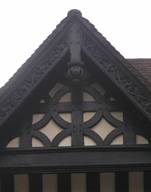This report was prepared by members of ECAD, Earlsdon Conservation and Development. ECAD was formed in 2003 in response to a controversial planning application for a site on Warwick Street. Following a series of public meetings and discussions between ECAD and the Developer, the application was withdrawn and a scaled down proposal was resubmitted which was subsequently approved. Since then ECAD has monitored planning applications for significant sites with a view to ensuring that proposed developments are in keeping with the scale, style and character of the Earlsdon area. During the last twenty years the rate of change in Earlsdon has increased significantly. Earlsdon, in a way, is a victim of its own popularity. It is a popular area to live in and to visit. This has caused a marked increase in traffic and its attendant parking problems.
In the last five years developers have noted the popularity of Earlsdon and have bought and developed a number of significant sites. The developments have been almost exclusively one or two bedroomed apartments with very little family accommodation being provided. Generally the architectural style has been a pastiche of the Victorian vernacular. None of them has been able to achieve the building quality, particularly brickwork, which our forefathers consistently achieved. Over 250 photographs were taken in the preparation of this report. They were gradually reduced as each zone was studied in terms of architecture and accompanying text. The aim has been to demonstrate photographically the overall architectural quality of the buildings, their materials and details.
As a contrast to the hard profiles of buildings Earlsdon’s other main character is one of a green suburb. Earlsdon was known as ‘the garden suburb’ and is still referred to as ‘the village’. Many of the streets are tree lined backed up by mature well cared for gardens. Additionally, the whole area is surrounded by swathes of green open space from the Kenilworth Road Conservation Area, War Memorial Park, Spencer Park, Hearsall Common, Canley Ford to the fairways of Hearsall Golf Club. It is this combination of mature landscape, small scale red brick buildings and larger scale more formal buildings which gives Earlsdon its distinctive character. In terms of Design Guidelines we have grouped the five zones into a single area because the development history of the zones began in 1852. Before that year the area was outside the city boundaries and consisted of open fields, a few farm buildings and two lanes – Whor Lane which became Beechwood Avenue and Elsdon Lane which became Earlsdon Avenue. Development, therefore, started in the mid Victorian period and defines the architectural style. In recent years the buoyant housing market has allowed home owners to improve or extend their properties. This has resulted in a variety of different solutions which have tended to weaken the character of the street scene. For example many natural slate roofs are over 100 years old and have reached the point where they need replacing. The old slates have been replaced with a variety of concrete tiles which have different profiles and colours. More recently synthetic slate tiles have become popular. External walls have been rendered, pebble dashed or painted (in some instances even terracotta details have been painted over). Original windows and doors have been replaced with UPVC versions. Front gardens have been paved over to provide parking spaces. Many residents living in Victorian/Edwardian properties are not aware or do not understand the correct way of dealing with lime built structures. Within the Spon End, Nauls Mill ALD document there is essential reading for homeowners of Victorian/Edwardian buildings. We recommend that a similar authoritative document is produced by the City Council especially to give guidance to home owners when wishing to make changes to their properties. It is hoped that a City Council Guidance Document would help home owners to follow a range of solutions which could be applied to properties of the pre 1920s era and would help to achieve a more consistent quality of conservation. The correct maintenance and conservation of buildings is vital for preserving the quality and heritage of Earlsdon.
ALD status would strengthen the planning process and would ensure the proper design approach to existing buildings where an application for a change of use was sought. Similarly it would give planners and residents a higher level of design expectation when considering applications for new developments. It would also ensure that the shopping area maintained a varied mix of shop types which would cater for all local needs. Although Earlsdon now stands within the city boundaries it still contains all the attributes of a ‘village’ – church, school, public house, shops and a range of dwellings from simple ‘two up/two down’ terraces with direct access onto the street to more substantial detached properties. As such Earlsdon is representational of our Victorian heritage nationwide.
|


